


Sample Game: Denisovan v. Neanderthal


1. White: d4 Black: d5


2. White: e4 Black: dxe4
If you decide to look at the sample game without first reading all the rules, it’s a good idea to keep in mind several distinctive features of the variant:
First, there are three sections of the board, each of which bestows a certain amount of sanctuary upon select pieces. These include the Court (the board’s perimeter) where the game’s novel piece, the Spy (or Cypher) dominates. Only major pieces, not pawns, can enter the Court. Such entry, always optional, must be triggered by the Spy’s exit from the area. The King enters the Court upon his own power, but he can only go there when the opposing Spy is not present. The Border is the middle row of the board. And all other squares are part of the Field. Major pieces cannot capture each other in the Field, on the Border (though the King can be checked by other major Border pieces), or within Court. Major pieces can attack major pieces in the Field from either the Border or Court. Pawns can attack pieces anywhere but Court. Finally, the Spy can capture major pieces in Court.
Second, when a major Border or Field piece captures a Field piece, it can be immediately retaken by another major piece in the Field. This is known as the Re-take rule.
Third, the rule of Infiltration, similar to castling in the classical variant, stipulates that if the King lands on the Border, he has the option of sending any piece but himself and the Spy to square d0 or d10.
And, fourth, the spatial dynamic of the game is in no small part defined by the rules governing Spy-King interaction. It is illegal for the Spy to land next to either King or the other Spy anywhere on the board. In Court, the Spy can defeat the opposing side by “flipping” the Court King if the former stays at least 1 empty square away and manages to line itself up with the latter along any straight trajectory— vertical, horizontal or diagonal, even from across the board. Anywhere outside of Court, the King can flip the opposing Spy by landing on the square adjacent to it.
These and the remaining rules make the variant appear a bit complicated but, arguably, it's not quite as complicated as some other major variants, like Shogi or Tamerlane.


3. White: bxe4 Black: Qd5


4. White: bf5 Black: Be6


5. White: Bxh7 Black: g6


6. White: Nd3 Black: Sd6; Qz5
(See rules for Knight movements)

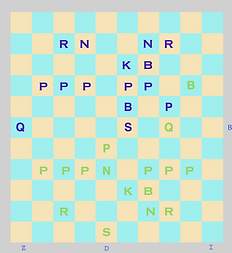
7. White: Qg5 Black: Se5+


8. White: Kd2 Black: Qz2+


9. White: Rb2 Black: f6



10. White: Qxg6 Black: Sg5+

11. White: f4 Black: Bxb3

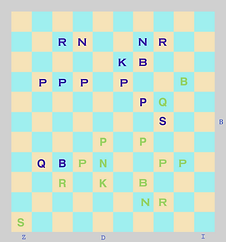
12 White: Sz0 Black: Qxa3
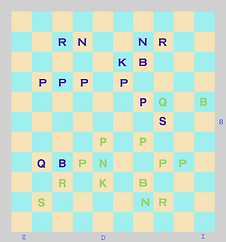

13. White: Sa1; Bi6 Black: Ng7


14. White: Be10 Black: c5

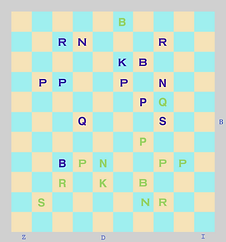
15. White: dxc5 Black: Qxc5


16. White: Bd4 Black: Si3


17. White: Qh5+ Black: Kd7


18. White: Nb4 Black: Qxc3


19. White: Qb5+ Black: Kc7


20. White: Nd5+ Black: Kd6


21. White: g4 Black: Si2+


22. White: Rg2 Black: Qxh3


23. White: Sz2+ Black: Ke6


24. White: Bxa7 Black: Sh2;Be0
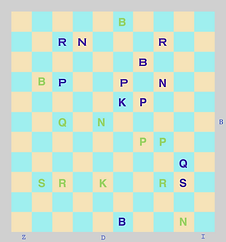

25. White: Sa2; Nh0 Black: Bxg2


26. Ne1 Black: f5


27. Nf3 Black: fxg4


28. Ng5+ Black: Kf5 (Infiltration): Qd0+


29. Ke2 Black: Qe0+


30. Kf3 Black: Si3+


31. Kf2 Black: g3+


32. Kf3 Black: Sf0
At this juncture, what is white's best response? He could interpose with the Rook that's on b2 or he could take the pawn on g3 with the King. The former might lead to Rf2 Sf1; Bio+
Kxg3 Nh5+
Kh4 Qh0+
Capturing the pawn looks equally bad for the Denisovan:
Kxg3 Nh5+
Kh4 Bh5+
Either of the following flight squares for white would lead to flipping by the Spy:
Ki4 Si2 or
Ki3 Sf0
Note: If you discover a notation error in the above game, feel free to use the email address on the "About" page to tell me about it.